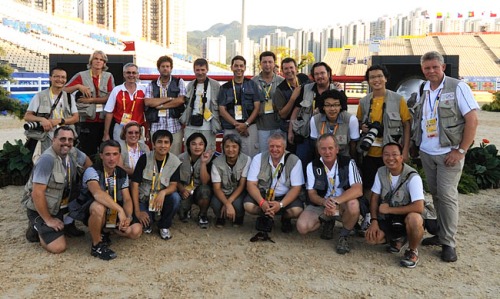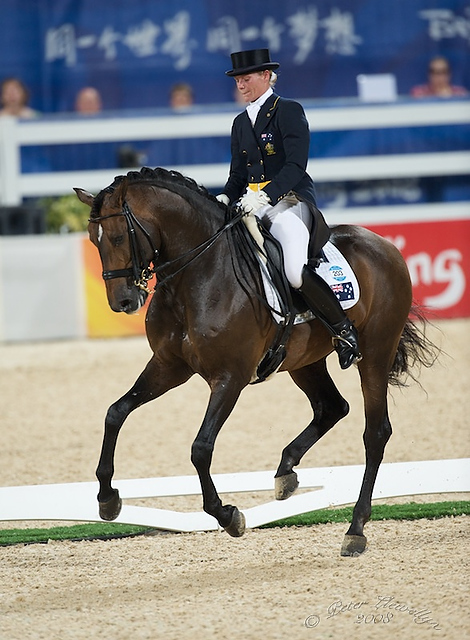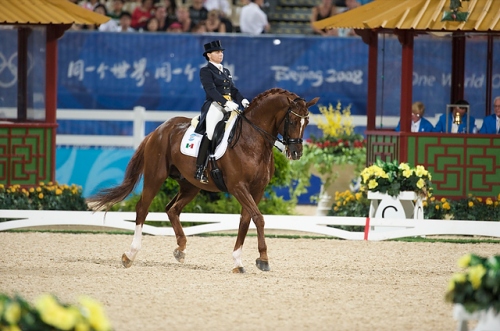In a repeat of the doping situation in Athens four years ago, a shock announcement by the FEI (following hours of speculation after the news was leaked to the media!), confirmed that four horses had tested positive to the banned substance ‘capsaicin’ a derivative of the chilli pepper plant. The riders were notified and hearings with the FEI Tribunal immediately scheduled, resulting in the suspensions being upheld and the riders disqualified from the individual final.
The four riders are Bernardo Alves/Chupa Chup (Brazil), Christian Ahlmann/Cöster (Germany), Denis Lynch/Latinus (Ireland) and Tony Andre Hansen/Camiro (Norway). Assuming the result of the B-samples are also declared positive, Norway will be stripped of their team bronze medal, which will be awarded to fourth-placed Switzerland.
According to an FEI advisory, capsaicin is classified as a doping prohibited substance due to its hypersensitizing properties, and also as a class-A medication administered for pain relief.
FEI Secretary General Alex McLin explained that in April 2008, the FEI changed the doping rules to allow provisional suspensions to take immediate effect, rather than waiting until after a competition is over.
According to the official announcement: “The FEI provisionally suspends all competitors who test positive in doping or positive medication cases at the Olympic Games in the interests of the integrity of the sport.
Christian Ahlmann was notified of his suspension yesterday (Wednesday) … A preliminary hearing was held at 10:00 this morning (Thursday, August 21) before a member of the FEI Tribunal who confirmed the suspension.
The other riders – Tony Andre Hansen, Bernardo Alves, Denis Lynch – were notified earlier today further to receipt of their positive test results this morning. All three of them were provisionally suspended.
Preliminary hearings were held with the respective National Federations in the following order: 14:00 Brazil; 15:00 Ireland; 16:00 Norway. The hearings were held before a member of the FEI Tribunal who confirmed the suspension.”
Naturally, confirmatory analysis of the B-samples will be carried out according to the accelerated procedure in place for the Olympic Games, and results for all four horses should be known within the next two days. (Fortunately, the Hong Kong Jockey Club’s drug-testing laboratory at Sha Tin racetrack is blessed with state-of-the-art equipment which has facilitated the extremely quick turn-around in testing blood and urine samples.)
In comparison, the forecast of major typhoon ‘Nuri’ due to hit Hong Kong tomorrow morning was overshadowed, and the organizers in Sha Tin were quick to reassure everyone that the final individual showjumping round would go ahead as planned. However, Dr. Leo Jeffcott, FEI Veterinary Delegate, announced that if necessary, in the case of a passing thunderstorm, the competition may be temporarily suspended, but there was no expectation that the event would not be completed this evening as scheduled.
When asked for his reaction to the doping scandal, and also to explain why it appears to be more prevalent in showjumping than in eventing and dressage, FEI vice president Sven Holmberg said; “This is a serious blow with possible implications for equestrian sport and jumping.” Adding that four suspensions for the same substance substantially increases the cause for concern. “From the FEI viewpoint, even if the situation is extremely serious, we have been able to have a turn-around time of four days and a procedure on the legal side that is prepared for these cases.”
As a result of the various suspensions, four non-qualified riders found themselves in first round of the individual showjumping final: Alberto Michan/Chinobampo Lavita (Mexico), Lotta Schultz/Calibra (Sweden), Camila Benedicto/Bonito Z (Brazil) and Taizo Sugitani/California (Japan), and of these, Benedicto produced a faultless performance and progressed to the second round.
Individual Final:
The courses for the individual rounds were naturally gargantuan in both size and technicality with combinations that demanded the greatest respect and required an accurate approach and huge scope. Apart from the treble, fence 6A/B/C, virtually every fence predictably claimed a victim.
First to go, Alberto Michan said he only learned at 2:30 p.m. this afternoon that he would be competing tonight. “This was my second chance. It’s a miracle. With the water I only touched it a little, then jumped the next fence good with his front feet, then touched a rail. She jumped great. I was very lucky to be here and she made me jump everything. She’s maybe not quite the same quality as other Olympic horses here, but we did our best and enjoyed the experience.” He added that Lavita’s story is a little special as he found her four years ago during a trip to stable in Chinobampa, one hour from Mexico [City], where she’d been abandoned for a year.” Fortunately for Michan, “We just clicked.” Their 12-fault round, however, spelled the end of their 2008 Olympic campaign.
For Benedicto, competing in her first Olympics, she only knew one month go that she would be riding in the team, and only learned four hours before this final round that she would be included. “I think I didn’t feel the responsibility the same as the other riders, so I rode more relaxed.” Commenting on team morale following the suspension of fellow team mate Bernardo Alves, Benedicto said, “I haven’t spoken to him yet. But it was a big surprise for everyone and we will have to see what’s going on afterwards.”
Second Mexican, Federico Fernandez, who qualified in the original top 35 was also pleased with his nine-year-old stallion Zorro. “I’m very pleased with the horse. He behaved super, and he’s still very green and needs to learn a bit, but he did much more than what I expected of him, for sure. I think every single one of the fences in the course will be a problem.” Adding his hopes for Zorro, Fernandez said, “I hope he will be super for the World Equestrian Games and hopefully, if I can keep him going and right in his mind, the next Olympic Games in London.”
Also benefiting from the rider suspensions, Lotta Schultz was delighted with her four-fault round with Calibra, saying, “I was told that I could take part at 2:30 this afternoon when I was doing some shopping. Tears came to my eyes when I heard it. It’s my lucky day. I never thought I would be able to take part in an Olympic round and I’m more than happy. It was a fantastic round.” In fact, Schultz was the last of the four faulters to qualify for tonight’s second round of 22 riders – including 10 who jumped clear.
Former Olympic Champion (Barcelona 1992), Ludger Beerbaum commented on his four faults in the first round, saying, “I rode with more pressure than yesterday to get the width for the water, but then could not get him [All Inclusive] back in time for the combination. I had a button of my shirt caught in the horse’s mane and was in front of the horse for the second [element]. Therefore, we were out of balance and had the mistake.” Discussing the suspension of his fellow countryman Christian Ahlmann, Beerbaum added, “Time is too short for deep thoughts. We learned about the whole thing only at 14:00. Of course, I thought ‘no this can’t be true’, but then I concentrated on what was ahead for me and I thought about my task of riding this individual final course. I cannot draw any conclusions. First I need to know exactly what has happened here.”
Other well-known riders who incurred four faults in the first, round included: Rodrigo Pessoa/Rufus, Edwina Alexander/Itot du Chateau, Gerco Schröder/Monaco, and Steve Guerdat/Jalisco Solier.
Of those riders who completed fautless first rounds, Beezie Madden, silver medalist at the 2006 World Equestrian Games in Aachen said, “He [Authentic] was great tonight. He has plenty of energy. This is probably one of the best jumps. We would like to aim high. I am very confident in my horse, but it’s showjumping and difficult to predict a winner. I think this is what makes it exciting.”
Likewise, Britain’s Tim Stockdale and Corlato, who have jumped well all week. “She is a careful mare and jumped so well. I’m delighted.” Regarding the course, “It rode pretty good. It’s more on the soft side than what we expected.” And, finally, commenting on the rider suspensions; “It’s not great for our sport, and it’s a bit of a worry”
By the end of two extremely tough rounds, there were seven riders with a total of four faults: Ludger Beerbaum, Meredith Michaels Beerbaum, Rodrigo Pessoa, McLain Ward, Angelique Hoorn, Beezie Madden and Marc Houtzager.
However, with four riders to go, Sweden’s Rolf-Goran Bengtsson pulled off the first double clear riding the La Silla bred Ninja, a small gelding that has the heart of a lion to compliment the elastic jump he unleashes over every fence. It left last to go, Canada’s Eric Lamaze and Hickstead to force a jump-off for the gold and silver medals, leaving the four faulters to battle it out for the bronze. Lamaze’s stallion didn’t disappoint.
The jump-off course provided a serpentine track with two switchbacks and a long gallop to the last fence, and first to go, Ludger Beerbaum/All Inclusive added four faults – thanks to an error at the penultimate fence – to their first-round score in a time of 36.16.
Shutterfly’s speed has already been demonstrated in numerous victorious jump-offs, and Michaels-Beerbaum unleashed his energy for a clear round in 35.37. “It would have been nice if I’d done that earlier, but I am happy with my horse. Shutterfly was super and I rode well. This was my first Olympics riding for Germany. Life goes on.” The pair finished fourth.
There was no doubting Rodrigo Pessoa’s intentions with Rufus, and although he jumped clear, the 10-year-old gelding lacks experience in pressure situations, and the Brazilian crossed the line in 37.04, good enough for a very creditable fifth place.
Riding for the USA, McLain Ward and Sapphire were the first combination to take a cheeky route which was a shortcut across an ornamental green swathe of turf and jumping a bush between the second and third fences. Although it made up some time, four faults at the last fence, relegated them to sixth place.
Angelique Hoorn for the Netherlands, didn’t attempt the shortcut, but motored from the starting line with O’Brien – a speed that was a little too optimistic and resulted in eight faults for ninth place.
Emulating her fellow countryman, Beezie Madden also steered Authentic over the bush and maintained a clean slate in the fastest time so far, 35.25, and was assured of the bronze medal with Marc Houtzager and Opium also dropped two rails for eighth place.
Finally, the jump-off between the two leaders saw Bengtsson go first with Ninja – a naturally fast gelding who won the 2007 World Cup qualifier at the CSI Monterrey last October. The pair produced a textbook round until the very last fence, when they took a flyer and a brick came out of the wall.
Although it gave Lamaze a small buffer, the Canadian couldn’t afford to be too cautious and risk incurring four faults in a slower time. However, Hickstead never needs much encouragement where speed is concerned and the very careful stallion launched himself around the course in brilliant style, rewarding Lamaze with Olympic gold.
“Redemption” was a word Lamaze used when asked how he felt – a small reference to the years of difficulty earlier in his career which he has managed to overcome. “You cannot come back to the sport without the support of your sponsors, friends and family. They made it impossible for me to try giving up. If this gold medal doesn’t make people forgive and stop talking about my past all the timek, I don’t know what will.”
Talking about Hickstead, Lamaze said, “I bought him as a seven-year-old from Stephen Conter in Belgium. He was not the easiest horse to teach, so we soon figured out we just had to leave him the way he is. Now he does everything from instinct and pure talent.” Continuing he said; “My horse is really careful and you can always count on him to give 100 percent effort. I have all the confidence in the worl [in him] and he makes my job very easy.”
Rolf-Goran Bengtsson was certainly not disappointed with his silver medal, describing Ninja as a very brave horse, and not so big. “He doesn’t think about jumping big fences. When I steer him at anything he will jump. He is a very sweet horse and it is always a real pleasure for me riding a horse like that.”
“I had a strong feeling all week, but I got a bit worried when the spectators shouted out at the corner of the water jump [liverpool] . I noticed that there was a little sea [pool of water] behind the jump. My mind went back to the incident in Athens when the gate [of a fence] fell down. I didn’t panic and stayed cool, and when I saw that it was taking too long to repair it, I took the horse out of the arena to remain calm, thinking that Eric was riding behind me with a super fast horse.”
Regarding his four faults at the final fence, “My horse became too strong and too forward in jumping the last brick wall, but he is a great winner today.”
For Beezie Madden, “When you saw the first round, it’s typical to have a jump-off for the medals, but when it ended with seven for the bronze that was a little too much, but it’s been a very exciting day. I think we were all expecting a bit of a long night. The second round course, in my opinion, was much bigger. I have to thank Mclain [Ward – for the shortcut]. He paved the way and told me what to do.”
Giving the final word to the 2008 Olympic Games gold medalist, Eric Lamaze, “He [Hickstead] felt good from the beginning tonight. In the second round he was feeling fresh and good. For days this has been only a dream, but now it is reality.”
Round 1: http://results.beijing2008.cn/WRM/ENG/INF/EQ/C73SF/EQX002101.shtml#EQX002101
Round 2: http://results.beijing2008.cn/WRM/ENG/INF/EQ/C73SG/EQX002102.shtml#EQX002102
Jump-off: http://results.beijing2008.cn/WRM/ENG/INF/EQ/C73SG/EQX002103.shtml#EQX002103







